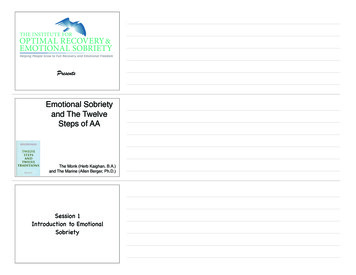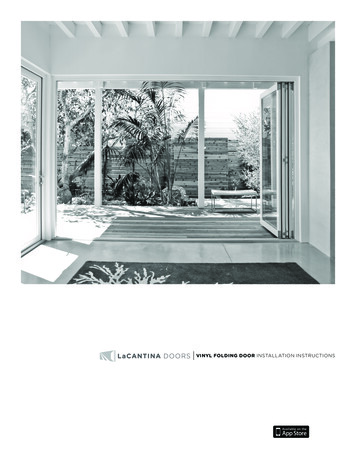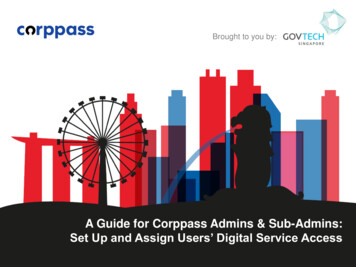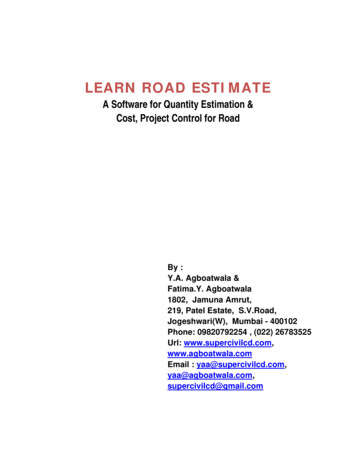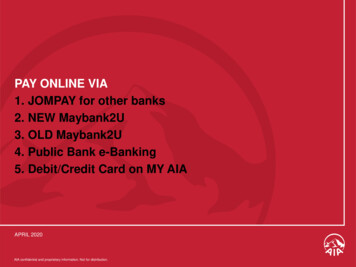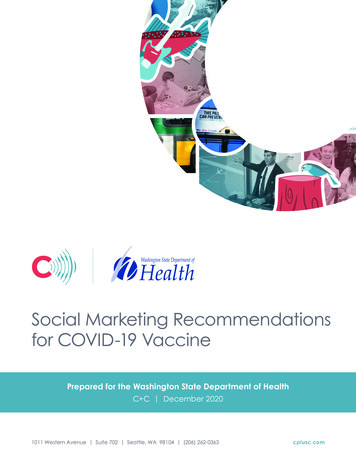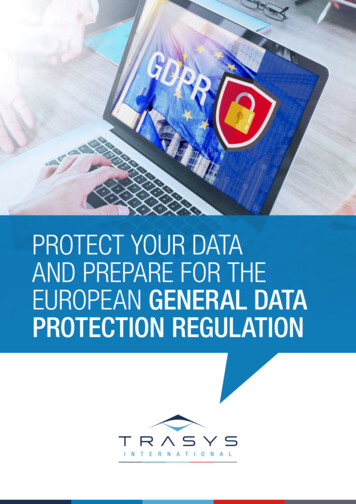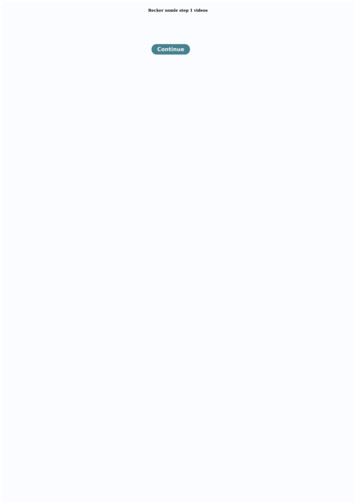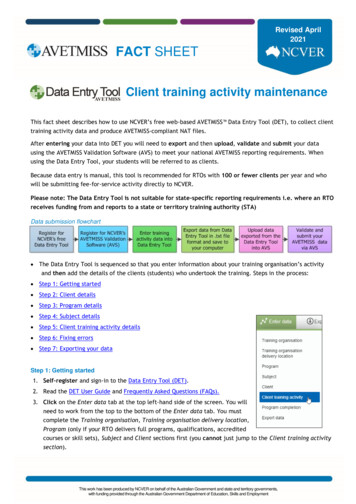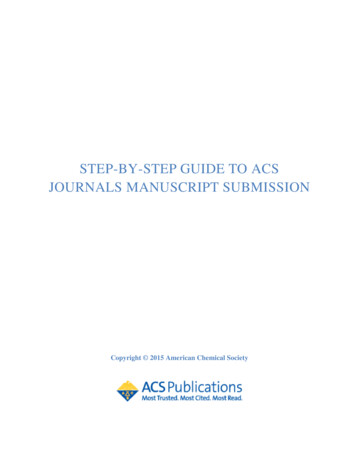
Transcription
STEP-BY-STEP GUIDE TO ACSJOURNALS MANUSCRIPT SUBMISSIONCopyright 2015 American Chemical Society
TABLE OF CONTENTSSTEP 1: Choosing a Journal . 4STEP 2: Preparing for Submission . 5Ethical Guidelines . 5Conflict of Interest Disclosure . 5Author List and Coauthor Notification . 5Copyright and Permissions . 6Journal Publishing Agreement . 6Obtaining Permission from Copyright Owners . 6Funder Reporting Requirement. 6STEP 3: Assembling the Manuscript . 7Document Templates . 7Acceptable Software and Tex/LaTeX . 7Writing Style and Language Usage. 7Cover Letter . 8Manuscript Components . 8Graphics . 9Table of Contents/Abstract Graphic . 9Cover Images . 9Web Enhanced Objects (WEO) . 9Crystallographic Information Files (CIF) . 9Step 4: Submitting the Manuscript . 11Starting a Submission . 11Registering for ACS Paragon Plus . 11Completing the Submission . 11Managing Peer Review . 12
STEP 5: Checking Galley Proofs . 13Galley Proofs . 13Open Access Compliance and ACS AuthorChoice . 13Step 6: Publicizing Your Article . 14Publication Date and Patent Dates . 14Just Accepted Manuscripts. 14ASAP Publication . 14Corrections . 15Sharing Your Published Article . 15E-Prints . 15Reprints . 15
STEP 1: CHOOSING A JOURNALACS publishes peer-reviewed journals with cutting-edge articles across a broad spectrum ofscientific disciplines. In this step, you will choose the appropriate journal for your manuscriptsubmission.Some authors write first and then decide on the mostappropriate journal for their research. Others prefer totarget the manuscript toward a specific journal. Whichevermethod you use, be sure to become familiar with thejournal’s editorial scope, its policy on prior publication, itsformat, and especially its Author Guidelines.ACS Journals Scope, ImpactFactor, and Total CitationsEach journal offers free access to the first issue of the current year as a Sample Issue. Examine theSample Issue to help determine the journal’s style, editorial voice, and target audience.
STEP 2: PREPARING FOR SUBMISSIONBe sure to consult the journal-specific Author Guidelines for details on each journal’s additionalpolicy requirements.ETHICAL GUIDELINESAll parties—editors, reviewers, and authors—are expectedto adhere to the standards outlined in the AmericanChemical Society’s Ethical Guidelines to Publication ofChemical Research.Ethical Guidelines to Publicationof Chemical ResearchThe following policies are of particular importance for authors.CONFLICT OF INTEREST DISCLOSUREA statement describing any financial conflicts of interest or lack thereof is published with eachmanuscript. During the submission process, the Corresponding Author must provide thisstatement on behalf of all authors of the manuscript. The statement should describe all potentialsources of bias, including affiliations, funding sources, and financial or management relationships,that may constitute conflicts of interest. The statement will be published in the final article. If noconflict of interest is declared, the following statement will be published in the article: “Theauthors declare no competing financial interest.”AUTHOR LIST AND COAUTHOR NOTIFICATIONAuthors are required to obtain the consent of all their coauthors prior to submitting a manuscriptfor publication. If any change in authorship is necessary after a manuscript has been submitted,the Corresponding Author must e-mail or fax a copy of a signed letter to the Editor-in-Chiefconfirming that all of the original coauthors have been notified and have agreed to the change. Ifthe change involves the removal of a coauthor’s name, the Corresponding Author must, inaddition, arrange for the coauthor involved to e-mail or fax a copy of a separate signed letterconsenting to the change. No changes in the author list will be permitted after a manuscript hasbeen accepted.During manuscript submission, the submitting author must provide contact information (fullname, email address, institutional affiliation and mailing address) for all of the co-authors.Because all of the author names are automatically imported into the electronic Journal PublishingAgreement, the names must be entered into ACS Paragon Plus in the same sequence as theyappear on the first page of the manuscript. (Note that co-authors are not required to register inACS Paragon Plus.) The author who submits the manuscript for publication accepts theresponsibility of notifying all co-authors that the manuscript is being submitted. Deletion of anauthor after the manuscript has been submitted requires a confirming letter to the Editor-in-Chieffrom the author whose name is being deleted.
COPYRIGHT AND PERMISSIONSJOURNAL PUBLISHING AGREEMENTA properly completed and signed Journal PublishingJournal Publishing AgreementAgreement (JPA) must be submitted for each manuscript.Forms and InstructionsACS Paragon Plus provides an electronic version of theAgreement that will be available on the My AuthoringActivity tab of the Corresponding Author's Home page once the manuscript has been assigned toan Editor. A PDF version of the Agreement is also available, but Authors are strongly encouragedto use the electronic Journal Publishing Agreement. If the PDF version is used, all pages of thesigned PDF Agreement must be submitted. If the Corresponding Author cannot or should notcomplete either the electronic or PDF version for any reason, another Author should complete andsign the PDF version of the form.OBTAINING PERMISSION FROM COPYRIGHT OWNERSThe authors are responsible for obtaining any permissionPermission Requests and Creditnecessary to reproduce tables, figures, charts, schemes,Linesphotographs, text excerpts, etc., from the copyright owner.An author must also obtain permission to use her/his ownmaterial if s/he transferred copyright or plans to transfer copyright to a publisher other than ACS.If authors are using material that appeared in an ACS journal, and ACS owns copyright to thematerial, permission is not necessary. See Permission Requests and Credit Lines for completeinstructions and forms.FUNDER REPORTING REQUIREMENTAuthors are required to report funding sources and grant/award numbers.Enter ALL sources of funding for ALL authors in BOTHthe FundRef tool in ACS Paragon Plus and in yourmanuscript to meet this requirement.See also Open Access Compliance and ACS AuthorChoice.Instructions for Funder Reporting
STEP 3: ASSEMBLING THE MANUSCRIPTBe sure to consult the journal-specific Author Guidelines for details on each journal’srequirements. General information on the preparation of manuscripts for ACS Journals may alsobe found in The ACS Style Guide.DOCUMENT TEMPLATESMost ACS journals provide document templates for submission. Some journals require the use oftemplates, so be sure to consult the journal-specific Author Guidelines before formatting yourmanuscript.The templates facilitate the peer review process by allowing authors to place artwork and tablesclose to the point where they are discussed within the text. Use U.S. Letter (8 1/2" by 11") papersize setting in the word processing program as the original document page size for preparation ofall manuscripts. Do not use A4 or other size paper settings.Read the appropriate README file before downloading the template. This file contains detailedinformation on what to expect when you download and use a template.ACCEPTABLE SOFTWARE AND TEX/LATEXSee the list of Acceptable Software and appropriate File Designations to be sure your filetypes arecompatible with the submission system.If your word processor’s “Track Changes” function has been used, all changes must be accepted(incorporated as final) before the manuscript is submitted.ACS Authors have two distinct options for submittingwork authored in TeX/LaTeX, and the achemso stylepackage is also available to assist with manuscriptpreparation.Preparing and SubmittingTeX/LaTeX ManuscriptsWRITING STYLE AND LANGUAGE USAGEAuthors should consult The ACS Style Guide for guidanceon style, word-usage conventions, nomenclature, physicalquantity symbols and units, abbreviations, use of italics,and punctuation. The ACS Style Guide also provides insighton what editors and reviewers look for in evaluatingmanuscripts. Spelling and use of periods and commas innumbers should conform to U.S. usage.The ACS Style GuideACS ChemWorx English EditingServiceAny author who is not fluent in English may want to consider obtaining assistance withmanuscript preparation from a colleague whose native language is English to help eliminate errorsin style and grammar. Alternatively, authors may want to have their manuscripts editedprofessionally before submission to improve clarity. The ACS ChemWorx English Editing
Service can provide language editors who are native English speakers and who have completed anadvanced degree in your area of study, to help you polish your work.COVER LETTERA cover letter must accompany every manuscript submission. During the submission process, youmay type it or paste it into the submission system, or you may attach it as a file.Consult the journal-specific Author Guidelines for details on requirements of the cover letter.MANUSCRIPT COMPONENTSThe following items are parts of the typical article manuscript. Consult the journal-specificAuthor Guidelines for details on each journal’s requirements.Title. Titles should clearly and concisely reflect the emphasis and content of the manuscript andbe accessible to a broad audience.Author List. Include all those who have made substantial contributions to the work. To facilitateindexing and retrieval and for unique identification of an author, use first names, initials, andsurnames (e.g., John R. Smith) or first initials, second names, and surnames (e.g., J. RobertSmith). At least one author must be designated with an asterisk as the “Corresponding Author”—the person to whom correspondence should be addressed.Abstract. A summation of the most important results and conclusions.Body Text. The main content of the manuscript.Acknowledgement. This section should acknowledge financial support, technical assistance,advice from colleagues, gifts, etc.References. Consult each journal’s Author Guidelines for details on how to style references.Journal titles in the Reference list should be abbreviated according to Chemical Abstracts ServiceSource Index (CASSI, ml). The Referenceschapter [PDF] of The ACS Style Guide is available at no charge, for additional guidance.Supporting Information. This information is provided to the reviewers during the peer-reviewprocess and is available to readers of the published work. Supporting Information must besubmitted at the same time as the manuscript. See the list of acceptable filetypes.It’s a good idea to confirm that your Supporting Information is viewable. Viewers for SupportingInformation (SI) filetypes are freely available on the Web so you can check your supportinginformation.If Supporting Information is included for publication, add a statement at the end of the manuscriptindicating the nature of the material and the means by which an interested reader may obtaincopies directly:Supporting Information Available: [Description of material.] This material isavailable free of charge via the Internet at http://pubs.acs.org.
GRAPHICSThe quality of the illustrations in ACS journals depends on the quality of the originals providedby the authors. Figures are not modified or enhanced by the journal production staff.All graphics (illustrations) must be prepared and submitted in digital format. Each journaldetermines how the graphics should be provided. Some journals want them to be placed in textwhere called out. Others want them to be placed at the end of the manuscript file or uploadedseparately. Consult the journal-specific Author Guidelines for details.Any graphic (figure chart, scheme, or equation) that hasappeared in an earlier publication should include a creditline citing the original source. Authors are responsible forobtaining written permission to re-use this material.Permission Request FormAdditional guidance on creating graphics for manuscripts may be found in The ACS Style Guide,chapters 15 (Figures), 16 (Tables), and 17 (Chemical Structures).TABLE OF CONTENTS/ABSTRACT GRAPHICMost ACS journals require a graphic for the Table of Contents for certain manuscript types. Thisgraphic should be submitted along with the original manuscript submission. It is also displayedwith the Abstract.Consult the journal-specific Author Guidelines for details on each journal’s requirements.COVER IMAGESMost ACS journals publish artwork on the cover. For thesejournals, authors are encouraged to submit images suitablefor use on the cover.Guidelines for Table ofContents/Abstract Graphic [PDF]Consult the journal-specific Author Guidelines for details on each journal’s requirements.WEB ENHANCED OBJECTS (WEO)The Web editions of ACS journals allow readers to view multimedia attachments such asanimations and movies that complement understanding of the research being reported.WEOs should be uploaded in ACS Paragon Plus with ‘Web Enhanced Object’ selected as the filedesignation. A list of compatible WEO formats is available .html.CRYSTALLOGRAPHIC INFORMATION FILES (CIF)Crystallographic Information Files should be furnished as supporting information. Some journalsalso accept structure factor tables and these should also be furnished as supporting information.Check each journal’s Author Guidelines to see whether or not the specific data types should alsobe deposited in a crystallographic database.
Before being submitted, CIFs should be checked using the free checkCIF data-validation utility.Copies of the checkCIF data-validation reports should be retained in case a reviewer or editor hasa question about the data; they should not be submitted as supporting information.
STEP 4: SUBMITTING THE MANUSCRIPTManuscripts, graphics, supporting information, and required forms must all be submitted in digitalformat through the ACS Paragon Plus online submission site. Hardcopy manuscripts are notaccepted.Authors must also submit all revisions of manuscripts via ACS Paragon Plus.Be sure to review the journal’s Author GuidelinesSimple Submission Checklistcarefully before proceeding to the submission site. Close[Word]attention to all of the requirements will help expeditereview and reduce the time to publication. A SampleChecklist is available to help authors assemble all the materials needed for a quick and easysubmission.STARTING A SUBMISSIONTo begin a manuscript submission, the CorrespondingGo to the ACS Paragon PlusAuthor clicks on one of the links for “Authors &Submission SiteReviewers” from most pages on the PUBS Web site.Alternatively, each journal site has a link to “Submission& Review”. The URL http://paragonplus.acs.org/login points directly to the submission site.REGISTERING FOR ACS PARAGON PLUSBefore submitting a manuscript, the Corresponding Author (or a designee who will be making thesubmission and handling the peer review process) must register on the ACS Paragon Plus Website. Once registered, an author may submit manuscripts to any ACS journal and may check theprocessing status of submitted manuscripts.The submission site employs state-of-the-art security mechanisms to ensure that all electronicallysubmitted manuscripts are secure. These same security mechanisms are also utilized throughoutthe peer-review process, permitting access only to editors and reviewers who are assigned to aparticular manuscript.Complete instructions for registering and navigating the submission process are contained insidethe submission system.COMPLETING THE SUBMISSIONAfter logging in to ACS Paragon Plus, the Corresponding Author selects the appropriate journalfor submission from the pulldown menu on this page, called the Home page. Users can alsomanage previously submitted manuscripts and handle reviews, etc., from the tabs labeled “MyAuthoring Activity” and “My Reviewing Assignments”.After selecting a journal, the Corresponding Author fills out all of the requested information,beginning with Step 1 and continuing until all pertinent information and necessary files have been
provided. At this time, the Corresponding Author will make decisions about whether themanuscript will be published as Just Accepted.The manuscript file accessed by the reviewers is a PDF version of the manuscript submitted bythe Corresponding Author. Authors may either submit both versions, or they may submit only therequired word-processor or TeX/LaTeX version, and have the system create the PDF version fortheir inspection prior to the final step of manuscript submission. See File Upload Options fordetails on which files should be submitted.Authors will view and approve the PDF version of their manuscripts prior to formal submission tothe Editor.MANAGING PEER REVIEWUpon successfully submitting the manuscript, the Corresponding Author begins to receive emailsfrom the ACS Paragon Plus system and from the Assigned Editor about the peer review process.The Assigned Editor will request manuscript revisions if needed, and any necessary forms such asthe Journal Publishing Agreement.Please note that editorial decisions are based on many factors. Reviewer concerns are consideredvery seriously. The editors will expedite any additional rounds of reviews to ensure a timelydecision.
STEP 5: CHECKING GALLEY PROOFSIf a manuscript is accepted, and the Corresponding Author has indicated that the manuscriptshould be published as a Just Accepted manuscript, the peer-reviewed but unedited manuscript isusually published on the ACS Publications Web site as a PDF file within 30 minutes to 24 hoursafter acceptance.GALLEY PROOFSMeanwhile, the manuscript moves on to the production phase. After all revisions needed to satisfythe comments of the reviewers have been made, and all forms have been submitted, themanuscript is sent to Journal Production for editing and composition. There, galley proofs arecreated.Correction of the galley proofs is the responsibility of the Corresponding (submitting) Author.The Corresponding Author of an accepted manuscript will receive e-mail notification andcomplete instructions when page proofs are available for review. Alterations should be restrictedto serious changes in interpretation or corrections of data. Extensive or important changes on pageproofs, including changes to the title or list of authors, are subject to review by the editor.It is the responsibility of the Corresponding Author to ensure that all authors listed on themanuscript agree with the changes made on the proofs. Galley proofs should be returned within48 hours in order to ensure timely publication of the manuscript.OPEN ACCESS COMPLIANCE AND ACS AUTHORCHOICEAt this point in the process, authors should be considering whether to take advantage of ACSAuthorChoice to make their articles freely available upon publication—and/or to comply with theOpen Access policies of their funding agencies.The ACS AuthorChoice option establishes a fee-based mechanism for authors or their researchfunding agencies to sponsor the open availability of their articles on the Web at the time of onlinepublication. Under this policy, the ACS as copyright holder will enable unrestricted Web access toa contributing author’s publication from the Society’s Web site in exchange for a fixed paymentfrom the sponsoring author. ACS AuthorChoice will also enable participating authors to postelectronic copies of published articles on their own personal Web sites and institutionalrepositories for noncommercial scholarly purposes and allow immediate open access to an articleas soon as it is published on the ACS Web site.
STEP 6: PUBLICIZING YOUR ARTICLEPUBLICATION DATE AND PATENT DATESAccepted manuscripts will be published on the ACS Publications Web site as soon as page proofsare corrected and all author concerns are resolved. The first date on which the document ispublished on the Web is recorded on the Web article and in a separate line at the bottom of thefirst page of the document in the printed issue.Publication of manuscripts on the Web may occur weeks in advance of the cover date of the issueof publication. Authors should take this into account when planning their patent and intellectualproperty activities related to a document and should ensure that all patent information is availableat the time of first publication, whether Just Accepted, Articles ASAP, or issue publication.All articles published ahead of print receive a unique Digital Object Identifier (DOI) number,which is used to cite the manuscript before the print publication.JUST ACCEPTED MANUSCRIPTSJust Accepted manuscripts are peer-reviewed, acceptedmanuscripts that are posted on the ACS Publications WebFrequently Asked Questionssite prior to technical editing, formatting for publication,about Just Accepted Manuscriptsand author proofing—usually within 30 minutes to 24hours of acceptance by the editorial office. During themanuscript submission process, Authors can choose to have their manuscripts posted online asJust Accepted manuscripts. To ensure rapid delivery of the accepted manuscript to the Web,Authors must adhere carefully to all requirements in the journal’s Author Guidelines. If an authorchooses to have a manuscript published online as a Just Accepted manuscript, it is consideredpublished when the Just Accepted version appears on the Web. All activities pertaining to patentsand intellectual property must be completed before this time. Note that publishing a manuscript asJust Accepted is not a means by which to comply with the NIH Public Access Mandate.ASAP PUBLICATIONPublication on the Web as an ASAP Articlecould occur almost immediately or within just afew working days of receipt of the page proofcorrections. Authors should take this scheduleinto account when planning intellectual andpatent activities related to a manuscript.The actual date on which an accepted paper ispublished on the Web is recorded on the Web version of the manuscript and on the first page ofthe PDF version. An article may remain an ASAP article until it is assigned to an issue. In somecases, articles will bypass publication as ASAP and instead become part of a published issueimmediately.
CORRECTIONSIf errors of consequence are detected in a published paper, the author should send a correction viathe ACS Paragon Plus Environment for publication in the journal’s Additions and Correctionssection. All corrections are made at the discretion of ACS.SHARING YOUR PUBLISHED ARTICLEE-PRINTSCorresponding Authors will receive information for sharing free electronic downloads of theirpublished manuscripts via an author-directed URL.Under the ACS Articles on Request policy, the Society will provide (free of charge) to allcontributing authors a unique URL within the ACS Web site that they may e-mail to colleagues orpost on external Web sites. These author-directed links are designed to facilitate distribution of anauthor’s published work to interested colleagues in lieu of direct distribution of the PDF file bythe author. The ACS Articles on Request policy allows 50 downloads within the first year afterWeb publication and unlimited access via the same author-directed links 12 months after Webpublication.The ACS AuthorChoice option establishes a fee-based mechanism for authors or their researchfunding agencies to sponsor the open availability of their articles on the Web the time of onlinepublication. Under this policy, the ACS as copyright holder will enable unrestricted Web access toa contributing author’s publication from the society’s Web site in exchange for a fixed paymentfrom the sponsoring author. ACS AuthorChoice will also enable participating authors to postelectronic copies of published articles on their own personal Web sites and institutionalrepositories for noncommercial scholarly purposes and allow immediate open access to an articleas soon as it is published on the ACS Web site.REPRINTSWhen authors are sent the galley proofs of their paper, they will receive a link to a Web site wherethey may order author reprints. They may also call Cierant Corporation, 866-305-0111, from9AM to 5PM EST. Reprints will be shipped within two weeks after the issue publication date.Neither the Editors nor the Washington ACS Office keeps a supply of reprints; requests for singlecopies of papers should be addressed to the Corresponding Author.Under the ACS Articles on Request policy, the Society will provide (free of charge) to allcontributing authors a unique URL within the ACS Web site that they may e-mail to colleagues orpost on external Web sites. These author-directed links are designed to facilitate distribution of anauthor’s published work in lieu of direct distribution of the PDF file by the author. The ACSArticles on Request policy allows 50 downloads within the first year after Web publication andunlimited access via the same author-directed links 12 months after Web publication.
method you use, be sure to become familiar with the journal's editorial scope, its policy on prior publication, its format, and especially its Author Guidelines. . STEP 3: ASSEMBLING THE MANUSCRIPT Be sure to consult the journal-specific Author Guidelines for details on each journal's requirements. General information on the preparation .
